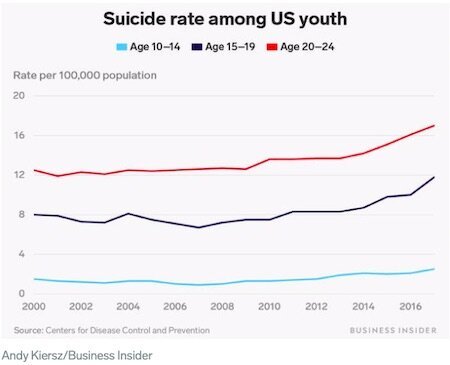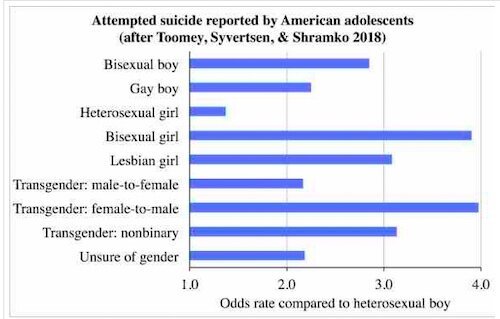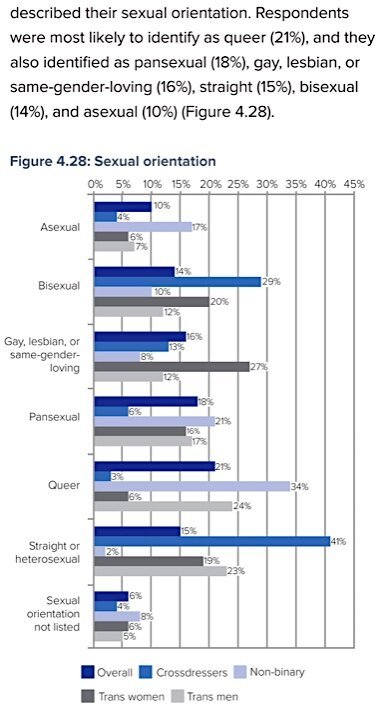Gender Dysphoria and Other Mental Health Issues are Rising in Teens
News
This post will add information about the rising rates of gender dysphoria and other mental health issues.
Recent Trans Mental Health Studies Criticized
Michael Biggs has been criticizing a study involving giving puberty blockers to tweens/teens, Costa (2015), that claims puberty blockers are psychologically beneficial. This study is from the Gender Identity Services (GIDS) in Britain, and Biggs writes the benefits to the patients may be exaggerated by the researchers:
RESULTS
At baseline, GD adolescents showed poor functioning with a CGAS mean score of 57.7 ± 12.3. GD adolescents' global functioning improved significantly after 6 months of psychological support (CGAS mean score: 60.7 ± 12.5; P < 0.001). Moreover, GD adolescents receiving also puberty suppression had significantly better psychosocial functioning after 12 months of GnRHa (67.4 ± 13.9) compared with when they had received only psychological support (60.9 ± 12.2, P = 0.001).
CONCLUSION:
Psychological support and puberty suppression were both associated with an improved global psychosocial functioning in GD adolescents. Both these interventions may be considered effective in the clinical management of psychosocial functioning difficulties in GD adolescents.
He has published a letter about the Costa study stating the claim that blockers are beneficial is suspect.
He wrote another article about puberty blockers and the adverse effects on bone health which the researchers in the study also appear to downplay.
A Swedish study about trans people has been published using data from the registered Swedish public. This a beneficial longitudinal survey from an estimated 95% of their population. The study finds trans people have much higher rates for mental health problems and suicide risk.
Results:
Compared with the general population, individuals with a gender incongruence diagnosis were about six times as likely to have had a mood and anxiety disorder health care visit, more than three times as likely to have received prescriptions for antidepressants and anxiolytics, and more than six times as likely to have been hospitalized after a suicide attempt. Years since initiating hormone treatment was not significantly related to likelihood of mental health treatment (adjusted odds ratio=1.01, 95% CI=0.98, 1.03)…
But they state that with more time past medical transition attempts to access mental health services goes down. They say in the study this justifies medical transition: UPDATE: THE AMERICAN JOURNAL OF PSYCHIATRY NOW STATES THE DATA DOES NOT INDICATE SURGERY IMPROVES MENTAL HEALTH AND HAS ISSUED CORRECTIONS AFTER MULTIPLE LETTERS TO THE EDITOR EXPOSING THE STUDY’S FLAWS
However, increased time since last gender-affirming surgery was associated with reduced mental health treatment (adjusted odds ratio=0.92, 95% CI=0.87, 0.98).
Conclusions:
In this first total population study of transgender individuals with a gender incongruence diagnosis, the longitudinal association between gender-affirming surgery and reduced likelihood of mental health treatment lends support to the decision to provide gender-affirming surgeries to transgender individuals who seek them.
Mark Regenerus is a researcher out of the University of Austin who appears to have an anti-homosexual/bisexual bias. He wrote a much-criticized study that claims children of LGB parents do poorly and filed an amicus brief against same-sex marriage in federal court. Almost all research on children of gay or lesbian couples over the last several decades shows that children in gay/lesbian households do as well as other children. The study lumped in any single parent, divorced parent, or those with transient same-sex experiences all in together. This isn’t a comparison with a two parent home. The study was also criticized for sloppy data gathering and analysis. Criticism of Regnerus may be found here and the story was covered in the Washington Post and elsewhere. Due to this track record, GHQ corroborated his claims about the Swedish study.
Regnerus explains the data gathered in the study is very sound:
This is as good as it gets when it comes to studying transgender medical experiences and outcomes.
Like Biggs, Regnerus states the researchers’ claims of benefit of medical transition are inflated:
Data from a new study show that the beneficial effect of surgery for transgender people is so small that a clinic may have to perform as many as 49 gender-affirming surgeries before they could expect to prevent one additional person from seeking subsequent mental health treatment. Yet that’s not what the authors say. That the authors corrupted otherwise-excellent data and analyses with a skewed interpretation signals an abandonment of scientific rigor and reason in favor of complicity with activist groups seeking to normalize infertility-inducing and permanently disfiguring surgeries…
First, a word about the hormones: the study found no mental health benefits for hormonal interventions in this population. There is no effect of time since initiating hormone treatment on the likelihood of subsequently receiving mental health treatment. Given the surge in interest, demand, and supply of hormonal therapies to self-identified transgender persons today, you would think that it is a solution that pays obvious benefits in reduced subsequent need—over time—for treatment of mood or anxiety disorder, or hospitalization after a suicide attempt. Yet there was no statistically significant effect. In fact, the confidence intervals actually reveal a nearly significant aggravating effect of hormonal treatment on subsequent mental health needs.
It is the surgical effect, however, that has grabbed all the attention. Bränström and Pachankis detected a statistically significant effect of time since last “gender-affirming” surgery on reduced mental health treatment. The adjusted (for controls) odds ratio for this was 0.92, meaning that, among respondents diagnosed with “gender incongruence” who then received gender-affirming surgical treatment, the odds of being treated for a mood or anxiety disorder (in 2015) were reduced by about 8 percent for each year since the last surgery. In other words, it would appear that the surgery—or more typically, the series of surgeries—benefited their mental health.
The numbers are crunched here:
But the authors discuss a “linear decrease” in seeking subsequent mental health care that is simply not visible in the study’s graphs, where post-surgical mental health treatment hovers stably around 35 percent among those in their first nine years after surgery, and then drops to only 21 percent of those patients who are in their tenth (or higher) year since their last surgery. However, only 19 total respondents reported their last surgery as having been completed 10 or more years ago. By contrast, 574 (out of 1,018 total) reported their last surgery as having been conducted less than two years ago. (Surgical treatment is clearly surging.) This means that the apparently helpful overall effect of surgery is driven by this comparatively steep drop in mood/anxiety treatment among only 19 patients. By the math, that would seem to indicate that four out of these 19 Swedes (i.e., 21 percent) sought help in 2015 for mood/anxiety problems.
While the study reports the adjusted odds ratio of the overall effect of time since surgery (0.92), which I cannot replicate without having data access, you don’t need the data to calculate an unadjusted odds ratio from the information presented there. This can tell us the baseline effect of time since surgery on receiving mood and anxiety treatment, only without the controls (like age, income, etc.). Doing this reveals the fragility of the study’s key finding: if a mere three additional cases among these 19 had sought mental health treatment in 2015, there would appear to be no discernible overall effect of surgery on subsequent mental health. The study’s trumpeted conclusion may hinge on as few as three people in a data collection effort reaching 9.7 million Swedes, 2,679 of whom were diagnosed with gender incongruence and just over 1,000 of whom had gender-affirming surgery…
Another helpful statistic I calculated is called the NNT, or “Number Needed to Treat.” It’s a measure of clinical impact. In this study, the NNT appears to be a staggering 49, meaning the beneficial effect of surgery is so small that a clinic may have to perform 49 gender-affirming surgeries before they could expect to prevent one additional person from seeking subsequent mental health assistance 1. If no other treatment was available, or the treatment was not invasive and the hazards were insignificant, clinics might consider surgery a low-risk but low-payoff approach. But none of those applies here. Conducting 49 surgeries to secure one additional patient who benefits? Unheard of.
He goes on to criticize the optimistic interpretation of the research as justification for risky medical treatments:
Physicians should not be pushed to prescribe such profoundly consequential treatment by threat of call-out, malpractice suits, patient demand, or—in this case—the overreaching interpretations of quality data. Clinicians are being bullied into writing a radical prescription based on fear, not on sensible conclusions from empirical data…
This is not how normal medical research works.
He also criticizes a study on conversion therapy and suicidality here. He argues the framing was sloppy and conclusions overconfident.
First…
Psychiatrist and longtime gender identity expert Stephen Levine highlights the quandary facing professionals attempting to counsel transgender patients on the biological, social, and psychological risks posed by any treatment approach. Such risks are real and ought to be discussed. This is what ethical informed consent does. But in the USTS survey lingo, an ethical discussion of risk could be interpreted by the patient as “trying to stop you being trans.” In other words, obtaining informed consent may constitute GICE…
Second, the data come from a nonrandom, opt-in survey—the USTS—that only targeted networked, self-identified transgender or nonbinary persons by advertising their survey among “active transgender, LGBTQ, and allied organizations.” There’s nothing wrong with collecting data using a nonrandom approach like this—I’ve done it myself and will do it again. The problem is when such data are delivered to the reader, as these were, in a way that suggests the conclusions would be consonant with everyone who has identified as transgender or experienced gender identity disorder or dysphoria…
Third, building on the dubious perception of representativeness, the authors report “confidence intervals” for their statistical “estimates.” Why they do so is beyond me. It’s a charade.
Fourth, the authors seem largely uninterested in putting their implied causation—that past conversion attempts affect present mood and suicidality—to the test. Instead, a subtext of injustices committed against the respondents infuses the study, suggesting a decidedly external locus of control in the lives of transgender Americans…
Trans Youth, Mental Health, and Suicide Risk
*Suicide ideation is socially contagious in young people and caution in reporting is warranted to not sensationalize it or make things appear hopeless to troubled people. If you or someone you know is struggling with depression or has had thoughts of harming themselves or taking their own life, there's help for you and hope. The National Suicide Prevention Lifeline (1-800-273-8255) provides 24/7, free, confidential support for people in distress, as well as best practices for professionals and resources to aid in prevention and crisis situations.
GHQ strives to cover the issue of suicide risk as objectively as possible, and we never advocate shunning a transgender youth or minimizing their distress. One can find an objective review of the data around trans people and suicide risk in Topic 15 and a summary here.
A case study of a youth who attempted suicide despite a supportive environment provides salient quotes about current trans demographics:
Gender dysphoria (GD) among adolescents is not uncommon. A recent survey among high school students found that 1.2-2.7% considered themselves transgender or uncertain of gender [1-2]. Reports also suggest an increasing number of adolescents referred to specialized gender identity clinical services for the treatment of gender dysphoria [3]. Any clinician who cares for young patients should be well informed of the impact gender dysphoria and related treatments have on mental health. Awareness of the increased prevalence of depression, anxiety, and suicidal ideation among these individuals can prepare healthcare providers to anticipate and respond appropriately to their presentation.
A 2017 chart review from a transgender clinic in Cincinnati found that among youth aged 12-22 with a diagnosis of gender dysphoria, 58% had another psychiatric diagnosis, and 30.3% reported at least one suicide attempt [4]. Two similar studies support these findings, with attempted suicide rates of 31% and 26% among transgender or gender dysphoric adolescents [2, 5].
Recent cohorts of trans-identified youth seem to focus on weight issues heavily:
Discussion
While the long-term outcome of this patient remains to be seen, this is a significant example of the psychiatric complexity of gender dysphoria. Despite outpatient treatment and supportive family, this patient suffered from persistent suicidal ideation. The repeated expressions of extreme dissatisfaction with appearance were notable. It has been found that among transgender youth, a significantly greater proportion of those who had attempted suicide expressed weight-related body dissatisfaction than those who had not. They also had a higher rate of negative assessment by others of appearance [5]. More recently, another study confirmed a significant correlation between suicidality and a desire for weight change among adolescents with gender dysphoria [4]. There has long been a natural association between body dissatisfaction and gender dysphoria; however, these reports and this case highlight the importance of assessing the degree and characterization of body dissatisfaction as they may contribute to suicidal risk.
Just for perspective, several studies on the overall declining mental health and an increase in suicide risk in teens and young adults are included here:
Suicide rate for people aged 10 to 24 increased by 56% between 2007 to 2017, according to new data from the CDC.
-For children aged 10 to 14, the suicide rate tripled between 2007 to 2017 after years of decline.
-Suicide had increased among millennials, but the data suggests Gen Z might be most at risk for mental illness.
Social media seems to be a reason many people believe is a factor since the rise of it coincides with these increases:
Social media might be fueling the increase in mental illness, as Gen Z is the first truly digital generation. Pew Research Center found 45% of teens aged 13 to 17 said they use the internet "almost constantly." Over-use of social media can cause loneliness, depression, and anxiety, the Anxiety and Depression Association of America reported.
“Are Mental Health Disorder Rates in Youth Really Increasing?”
A 2019 Gallup poll found that sadness, anger, and fear have risen for the second consecutive year around the world.
However, it is also true that we’ve experienced a burgeoning of resources, the highest education rates ever in the country’s history, and an overall decreasing violent crime rate. The same innovations that are said to be isolating also allow us to express ourselves, connect with others around the world, and stay informed. Steven Pinker, a professor of psychology at Harvard University, showed that despite the bleak worldview of the 24/7 news cycle, many metrics reveal that we are living in the most peaceful time in human history.
A Rolling Stone article emphasizes the need to provide youth with support and hope:
That said, research does indicate that early intervention in the form of initiatives like suicide screening at emergency rooms and pediatricians’ offices does play a role in helping to prevent suicide, as does exposure to positive stories about people recovering from feelings of suicidal ideation. Which is why it’s important to interpret the CDC’s finding not as cause for panic or rampant speculation, but as a call for heightened awareness for teens who may be at increased risk.
Johnathan Haidt, the author of Coddling of the American Mind, discusses these increases in mental health problems. He also notes the fact that females are most at risk and offers some suggestions about how to approach this issue:
In 2018 Micheal Biggs (mentioned earlier) wrote an article about these increases affecting girls disproportionately when it comes to gender dysphoria for 4thwavenow (“A community of parents & others questioning the medicalization of gender-atypical youth”):
Micheal Biggs/4thwavenow: “Attempted suicide by American LGBT adolescents”
The graph above shows the estimated odds of a student reporting attempted suicide, compared to heterosexual boys. As the Advocate emphasized, teens who identified as female-to-male transgender had the highest risk of attempted suicide; the odds were four times higher than for heterosexual boys. What went unnoticed is that the risk was just as high for bisexual girls.
The next highest rates (triple the odds compared to heterosexual boys) were for bisexual boys, lesbian girls and for kids who identified as nonbinary. The latter’s sex was not recorded, but the majority are likely to be female; other survey evidence suggests that two-thirds of trans-identified adolescents are female (Eisenberg et al. 2017).
The next highest rates (roughly double the odds for heterosexual boys) were for gay boys, for male-to-female transgender kids, and for kids who were unsure of their gender identity (whose sex was not recorded). Finally, heterosexual girls had a significantly higher risk than heterosexual boys.
Stephanie Davies-Arai and Nic Williams’ critique of Stonewall’s School Report suggested that “[t]he ‘transgender’ category may just serve to cover up the scale of suicide attempts and self-harm rates of girls and young women.” Their conjecture is vindicated by this survey evidence from the United States.
“Reason Lost to Suicide in Trans Debate” is an article that lays out the politicization of the suicide issue in the debate around pediatric medical transition. There is increased suicide risk in dysphoric young people and at the same time this is often exaggerated and used to get the public to comply with activist demands:
Also troubling is the activist mantra that kids will kill themselves if the trans project encounters any obstacle, personal or political. Lillian says: “I don’t understand why this one mental health condition is the exception to international best practice around how we talk about suicide.” Some suicide appears contagious, hence the well-known advice: don’t harp on the risk for a specific group, don’t imply taking your life is a default option, don’t catastrophise setbacks, don’t oversimplify the causes of suicide. Activists rediscover the risk of suicide contagion when they misrepresent media coverage that questions their narrative.
This is an older survey but is included here for its interesting conclusion that people with alternative identities such as nonbinary and FtM are at greater risk for sexual assault:
There is a strong push to stop trans identity and gender dysphoria itself from being defined as a mental illness by trans activists and some doctors who provide trans healthcare. An example is provided by Dr. Micheal Frist and Dr. Jack Drescher who want it redefined in the next ICD-11 (“International Classification of Diseases”) and the DSM (a mental health diagnostic manual). They want it defined as a type of physical body defect that needs to be corrected and thus defined purely as a medical issue.
In the below screencap, Dr. Ray Blanchard mentions theories relating gender dysphoria to other body dysmorphias and paraphilias. He asks if those who have made this connection would argue for the same thing to apply to these other conditions. He is demonstrating that trans identity is politicized in ways other body dysmorphias aren’t:
References:
Attempted suicide by American LGBT adolescents. (2018, October 28). Retrieved from https://4thwavenow.com/2018/10/23/attempted-suicide-by-american-lgbt-adolescents/
Biggs, M. (2019). A Letter to the Editor Regarding the Original Article by Costa et al: Psychological Support, Puberty Suppression, and Psychosocial Functioning in Adolescents with Gender Dysphoria. The Journal of Sexual Medicine 16(12) 2043. doi.org/10.1016/j.jsxm.2019.09.002
Biggs, M. (2019, July 29). The Tavistock’s Experiment with Puberty Blockers. Department of Sociology and St Cross College, University of Oxford. Retrieved from http://users.ox.ac.uk/~sfos0060/Biggs_ExperimentPubertyBlockers.pdf
Bränström, R., Pachankis, J.E. (2019). Reduction in Mental Health Treatment Utilization Among Transgender Individuals After Gender-Affirming Surgeries: A Total Population Study. The American Journal of Psychiatry. doi.org/10.1176/appi.ajp.2019.19010080
D. Carpenter. (2015, May 10). A “reality check” for the Regnerus study on gay parenting [UPDATED]. The Washington Post. Retrieved from https://www.washingtonpost.com/news/volokh-conspiracy/wp/2015/05/10/new-criticism-of-regnerus-study-on-parenting-study/
Cheng, S., Powell, B. (2015). Measurement, methods, and divergent patterns: Reassessing the effects of same-sex parents. Social Science Research 52, 615-626. doi.org/10.1016/j.ssresearch.2015.04.005
Costa, R., Dunsford, M., Skagerberg, E, Holt, V., Carmichael, P., Colizzi, M. (2015). Psychological Support, Puberty Suppression, and Psychosocial Functioning in Adolescents with Gender Dysphoria. The Journal of Sexual Medicine 12(11), 2206 - 2214. doi.org/10.1111/jsm.13034
Day, D.S., Saunders, J.J., Matorin, A. (2019). Gender Dysphoria and Suicidal Ideation: Clinical Observations from a Psychiatric Emergency Service. Cureus. doi: 10.7759/cureus.6132
Dickson, E. (2019 October 18). Teen Suicide Is on the Rise and No One Knows Why. Rolling Stone. Retrieved from https://www.rollingstone.com/culture/culture-news/teen-suicide-study-increase-why-900711/?fbclid=IwAR0PUvjFbmcal-fZ4easCS266R37otmCguB-9T1gulKCylWnJTWNkWBag-M
Baiocco, R., Carone, N., Ioverno, S., Lingiardi, V. (2018). Same-Sex and Different-Sex Parent Families in Italy. Journal of Developmental & Behavioral Pediatrics 39(7). 555–563. doi: 10.1097/DBP.0000000000000583
Haidt, J. (n.d.). How to improve mental health using ideas from the book. The Coddling. Retrieved from https://www.thecoddling.com/better-mental-health
Kiersz, A., Akhtar, A. (2019, October 17). Suicide is Gen Z's second-leading cause of death, and it's a worse epidemic than anything millennials faced at that age. Business Insider. Retrieved from https://www.businessinsider.com/cdc-teenage-gen-z-american-suicide-epidemic?fbclid=IwAR0xFdMxxECTrJFnyKpSjUAxS8f6rq44ITk6LE7Pc0ooxEGcsnv-ZqrZnmk&utm_campaign=sf-insider-main&utm_medium=social&utm_source=facebook.com
Lane, B. (2019, November 2). Reason Lost to Suicide in Trans Debate. The Australian. Retrieved from https://www.theaustralian.com.au/inquirer/reason-lost-to-suicide-in-trans-debate/news-story/af31e3357a4ec08f9a3e91227b3424bf
Noam, G. (2019, November, 7). Are Mental Health Disorder Rates in Youth Really Increasing? Psychology Today. Retrieved from https://www.psychologytoday.com/us/blog/the-inner-life-students/201911/are-mental-health-disorder-rates-in-youth-really-increasing
Regnerus, M. (2019, September 18). Does “Conversion Therapy” Hurt People Who Identify as Transgender? The New JAMA Psychiatry Study Cannot Tell Us. Public Discourse. Retrieved from https://www.thepublicdiscourse.com/2019/09/57145/
Regnerus, M. (2015). How different are the adult children of parents who have same-sex relationships? Findings from the New Family Structures Study. Social Science Research 41(4). 752-770. doi.org/10.1016/j.ssresearch.2012.03.009
Regnerus, M. (2019, November 13). New Data Show “Gender-Affirming” Surgery Doesn’t Really Improve Mental Health. So Why Are the Study’s Authors Saying It Does? Public Discourse. Retrieved from https://www.thepublicdiscourse.com/2019/11/58371/
The Rocky Road to Removing Gender Dysphoria from DSM-5. (2019, November 1). Retrieved from https://newyorkcomingout.org/events/event/the-rocky-road-to-removing-gender-dysphoria-from-dsm-5
The Report from the 2015 U.S. Transgender Survey. (2015). Retrieved from http://www.ustranssurvey.org
Turban J.L., Beckwith N., Reisner S.L., Keuroghlian A.S. (2019). Association Between Recalled Exposure to Gender Identity Conversion Efforts and Psychological Distress and Suicide Attempts Among Transgender Adults. JAMA Psychiatry(11), 1-9. doi:10.1001/jamapsychiatry.2019.2285
In Trans Youth Suicide, LGBT Identities Science Tags trans mental health, trans children & teens









